In Nebraska, during the arrival of warblers in spring and summer, it is common to spot yellow birds, but during winter, the American Goldfinch stands out as the most frequently seen yellow bird in the area.
To aid in the identification of yellow birds you have spotted in Nebraska, this guide provides you with pictures, information for identification, song recordings, and details about their migration patterns.
The majority of yellow birds found in Nebraska are warblers, orioles, and tanagers, and sometimes the female birds of these species look quite different from their male counterparts.
This guide will make the process of identifying yellow birds much simpler, as it presents the information in the order of their common sightings in Nebraska during the spring and summer months of May and June, based on ebird checklists.
Yellow birds present in Nebraska throughout the year include the American Goldfinch, Western Meadowlark, and Cedar Waxwing.
During the summer months, you can expect to spot Baltimore Orioles, Yellow Warblers, Dickcissels, Common Yellowthroats, Orchard Orioles, Western Kingbirds, Eastern Meadowlarks, Yellow-headed Blackbirds, American Redstarts, Yellow-throated Vireos, Summer Tanagers, Scarlet Tanagers, Lesser Goldfinches, Yellow-throated Warblers, and Prothonotary Warblers.
For those interested in yellow birds during migration, keep an eye out for Yellow-rumped Warblers, Orange-crowned Warblers, Nashville Warblers, Wilson’s Warblers, Magnolia Warblers, Palm Warblers, Western Tanagers, Black-throated Green Warblers, Canada Warblers, Hooded Warblers, Pine Warblers, White-eyed Vireos, and Blue-winged Warblers.
Read on to discover and identify the yellow birds you have encountered.
A total of 31 yellow birds in Nebraska are listed below:
1. American Goldfinch
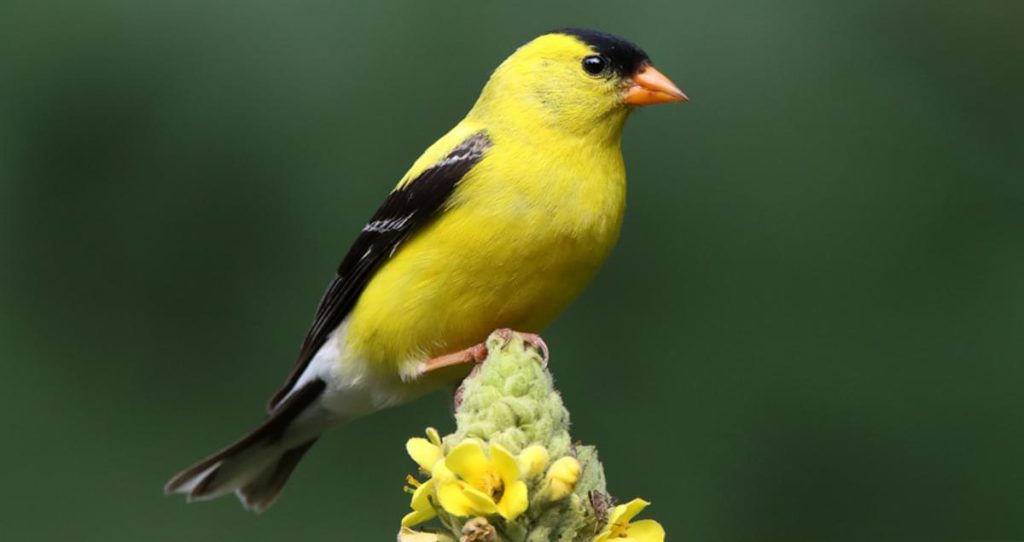
Throughout the year, American Goldfinches can be observed in Nebraska. Bird watchers have reported sightings of these birds in 35% of summer checklists and 29% of winter checklists in the state.
American Goldfinches are highly regarded birds, especially due to the vibrant yellow and black plumage of the males during spring. In winter, both males and females exhibit a duller brown coloring.
Spinus tristis
Length: 4.3-5.1 in (11-13 cm)
Weight: 0.4-0.7 oz (11-20 g)
Wingspan: 7.5-8.7 in (19-22 cm)
American Goldfinches can be found across most of North America and are usually permanent residents. However, those breeding in Canada and the Midwest migrate to the southern US for winter.
You can typically find American Goldfinches foraging for sunflower, thistle, and aster plants in weedy fields and overgrown areas. They are also commonly spotted in suburbs, parks, and backyards.
Listen to the song of the American Goldfinch:
American Goldfinch nests are typically built in shrubs using rootlets and plant material woven together and secured to branches with spiders’ webs. They lay up to seven eggs, which hatch in about two weeks, and the young leave the nest in two to two and a half weeks.
To attract American Goldfinches to your backyard, consider planting thistles and milkweed. They readily visit most bird feeders and have a preference for sunflower and nyjer seeds.
Fun Fact: Cowbirds are unsuccessful in getting American Goldfinches to raise their young as the finches’ vegetarian diet does not support the cowbird chicks, leading to their demise within a few days.
2. Western Meadowlark

Western Meadowlarks can be seen in Nebraska throughout the year, with a higher frequency during the breeding season. They are present in 31% of summer checklists and 5% of winter checklists in the state.
With their bright yellow bellies and melodious songs, Western Meadowlarks bring cheer to the surroundings.
These birds, belonging to the blackbird family, are roughly the same size as Robins. They have brown and white upperparts, with a black V-shaped band across their vibrant yellow chests that turns gray during winter.
Sturnella neglecta
Length: 6.3-10.2 in (16-26 cm)
Weight: 3.1-4.1 oz (89-115 g)
Wingspan: 16.1 in (41 cm)
Western Meadowlarks that breed in northern US states and Canada migrate to southern states during winter. However, those in the western and midwestern regions remain in Nebraska throughout the year.
You can typically find Western Meadowlarks on the ground in grasslands, meadows, and fields. They forage alone or in small flocks and are not commonly found in wooded areas or dense shrubbery.
The diet of Western Meadowlarks consists of insects and seeds. During summer, they primarily feed on insects such as grasshoppers, caterpillars, beetles, and crickets. In other seasons, they may rely more on seeds, weeds, grasses, and cultivated grains.
Listen to the pleasant tweets, warbles, and whistles of the Western Meadowlark:
Check out the video below to enjoy the beautiful whistles and warbles of this songbird.
Nests of Western Meadowlarks are constructed in depressions on the ground within grasslands. These nests are lined with soft materials like grass and may feature a roof made of grass and plant stalks.
To attract Western Meadowlarks to your backyard, provide sunflower seeds and cracked corn.
Fun fact: Western Meadowlarks have been designated as the state bird in six US states.
3. Female Baltimore Oriole

During the breeding season, Baltimore Orioles are the second most commonly observed yellow birds in Nebraska. They can be seen from mid-April to September and are noted in 32% of summer checklists.
Baltimore Orioles serve as vibrant signs of spring in the eastern regions of North America. Adult males exhibit bright orange and black plumage with white wing bars on their black wings.
The females display yellowish undersides and heads, along with grayish-brown wings and brownish-yellow backs. They are approximately the size of Robins but possess a more slender physique. These orioles are members of the blackbird family.
Icterus galbula
Length: 6.7-7.5 in (17-19 cm)
Weight: 1.1-1.4 oz (30-40 g)
Wingspan: 9.1-11.8 in (23-30 cm)
Baltimore Orioles breed in the eastern and central states of the US, including central-southern Canadian provinces and areas along the southern US border.
During winter, Baltimore Orioles migrate to Florida, Central America, and the Caribbean, often departing as early as July.
These birds can be found at higher elevations in open woodlands, along riverbanks, and at forest edges, where they forage for insects and fruits. They frequently visit parks and backyards as well.
The diet of Baltimore Orioles primarily consists of insects such as beetles, crickets, grasshoppers, spiders, and snails. They also contribute to pest control and consume various fruits. However, they can cause damage to crops like raspberries, mulberries, cherries, bananas, and oranges.
Listen to the flute-like sounds of Baltimore Orioles, which bring joy during spring. They also produce chattering and sharp alarm calls.
Attract Baltimore Orioles to your backyard by providing halves of oranges on a platform feeder or hanging them from trees. Oriole feeders filled with sugar water can also entice them. Additionally, planting fruit-bearing plants and nectar-rich flowers like raspberries, crab apples, and trumpet vines can be effective.
Fun fact: Baltimore Orioles construct remarkable hanging bag-like nests using intertwined fibers.
4. Yellow Warbler

Yellow Warblers spend the breeding season in Nebraska and can be spotted from April to October. They are recorded in 27% of summer checklists.
These small, brightly colored birds showcase yellow plumage with a touch of green on their backs. Male Yellow Warblers exhibit chestnut streaks on their breasts, while females and juveniles possess less vibrant coloring.
Setophaga petechia
Length: 4.7-5.1 in (12-13 cm)
Weight: 0.3-0.4 oz (9-11 g)
Wingspan: 6.3-7.9 in (16-20 cm)
Yellow Warblers undertake a lengthy migration to breed in Canada and the US, excluding southeastern states. They then return to Central and South America for winter. However, sightings during migration can occur in southeastern US states.
You can find Yellow Warblers near streams, wetlands, and thickets, as well as along field edges. They actively forage for insects such as caterpillars, midges, beetles, bugs, and wasps.
Listen to the song of the Yellow Warbler:
Nests of Yellow Warblers are situated in small trees or shrubs and are constructed using bark, grass, and woven plant materials, secured with spider webs. The nests are lined with softer materials like hair, feathers, and plant down.
Yellow Warblers lay up to seven eggs, which take around twelve days to hatch. The young ones remain in the nest for another ten days or so before leaving.
To attract Yellow Warblers to your backyard, provide suet, oranges, peanut butter, and plants with berries. Planting native insect-attracting plants without pesticides and maintaining a natural environment will also be appealing to them. Consider adding birdbaths with fountains near secluded planting areas to provide protection.
Fun fact: When Cowbirds attempt to lay their eggs in Yellow Warblers’ nests, the Warblers detect this intrusion and build new nests on top of the old ones, repeating this process up to six times!
5. Dickcissel
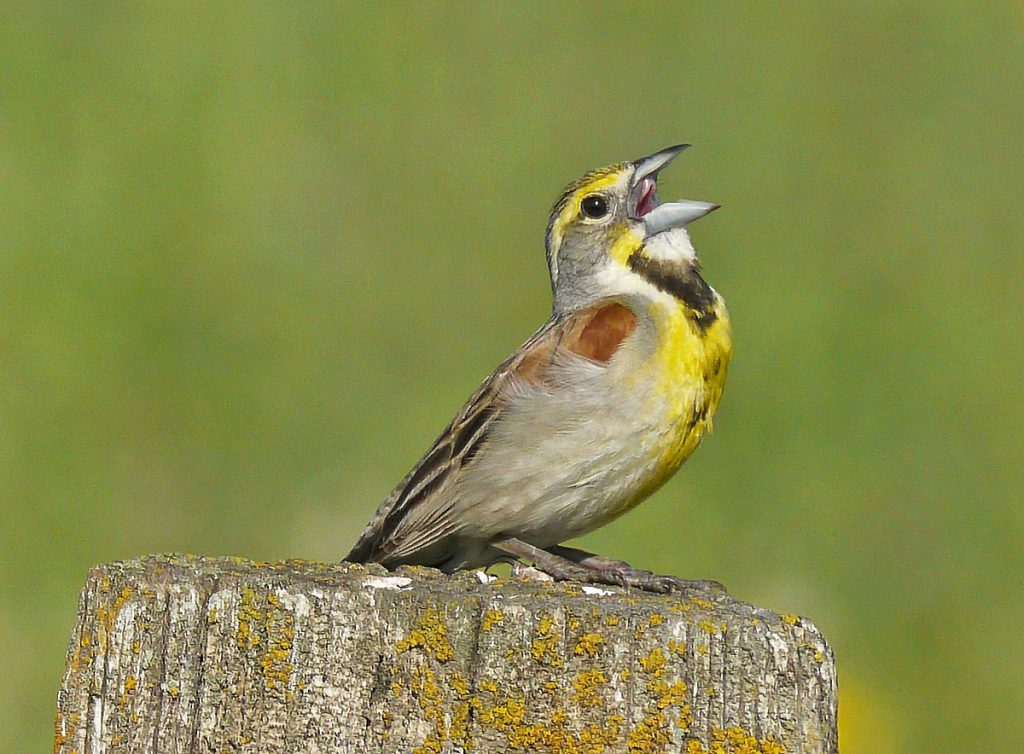
During the breeding season from April to October, Dickcissels are primarily observed in Nebraska. They appear in 26% of checklists during this time.
Male Dickcissels are striking and robust birds, featuring a distinct black throat patch and a yellow chest. Their grayish heads showcase a contrasting yellow eyebrow line. Females exhibit similar markings, but their overall coloration is slightly paler or duller. However, they lack a black throat patch, and the yellow chest is faintly visible.
Spiza americana
Length: 5.5-6.3 in (14-16 cm)
Weight: 0.9-1.4 oz (25.6-38.4 g)
Wingspan: 9.8-10.2 in (24.8-26 cm)
Dickcissels breed in the central and great plains of the US before migrating to Mexico, Central America, and northern South America.
These birds can be found in meadows, prairies, tall grasslands, lightly grazed pastures, and along roadsides.
Dickcissels feed on insects and seeds. During summer, they primarily consume grasshoppers, caterpillars, beetles, and crickets. In other seasons, their diet may consist of seeds, weeds, grasses, and cultivated grains.
Listen to the song of the Dickcissel:
Nests of Dickcissels are typically found in thick shrubs, grasses, and trees, reaching heights of up to four feet. The nests are bulky, constructed with weeds, grass, and leaves, and softened with fine grass and animal hair. The female may lay up to six eggs, which hatch in two weeks. The young are ready to fly after around ten days.
Fun fact: During fall migration, Dickcissels gather in large numbers, reaching millions as they reach their winter grounds.
6. Common Yellowthroat
Common Yellowthroats spend the breeding season in Nebraska and are primarily seen from April to October. They appear in 22% of summer checklists.
These small songbirds display brownish backs and vibrant yellow undersides, along with long tails. Male Common Yellowthroats feature black masks across their faces. The intensity of their yellow plumage may vary depending on geographical location, with some individuals exhibiting a more olive tone underneath.
Geothlypis trichas
Length: 4.3-5.1 in (11-13 cm)
Weight: 0.3-0.3 oz (9-10 g)
Wingspan: 5.9-7.5 in (15-19 cm)
During summer, Common Yellowthroats breed across most of North America, excluding Alaska and northern Canada. Some individuals remain year-round along the Gulf Coast and Pacific Southwest, while others migrate south for winter.
You can find Common Yellowthroats in marshy or wetland areas, as well as in brushy fields with thick, tangled vegetation.
Listen to the song of the Common Yellowthroat:
Nests of Common Yellowthroats are built near the ground in marshy areas, supported by reeds. The nests are made of grass and sedges, held together on a leaf and grass platform. They lay up to six eggs, which hatch in approximately twelve days, and the young ones leave the nest within the same time frame.
To attract Common Yellowthroats to larger backyards, ensure the presence of dense vegetation and native plants that attract insects.
Fun fact: The black mask of Common Yellowthroats serves as a signal to male suitors, triggering aggressive behavior towards fake birds with masks but no reaction when the bird lacks a mask.
7. Cedar Waxwing
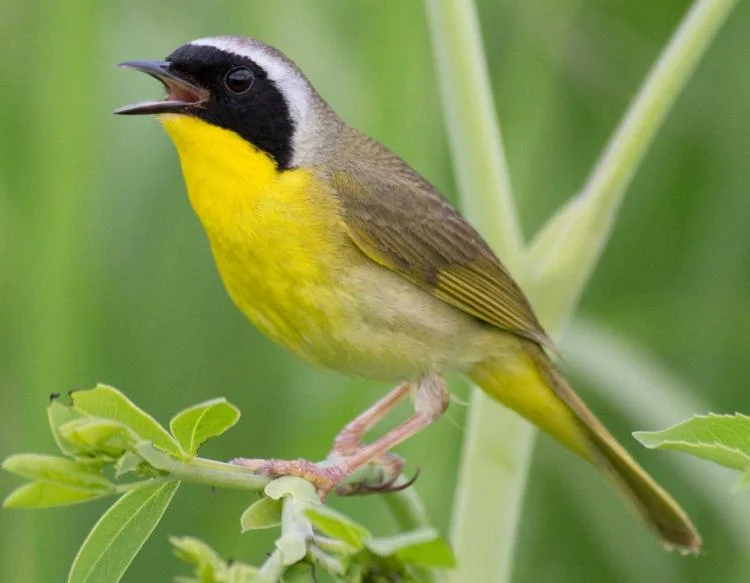
Cedar Waxwings can be seen in Nebraska throughout the year, with sightings recorded in 9% of summer checklists and 5% of winter checklists.
These elegant and sociable birds exhibit pale brown coloring on their heads, chests, and crests, which fades to gray on their backs and wings. Their bellies showcase a pale yellow hue, while their wingtips feature vibrant red accents. They also possess a narrow black mask over their eyes.
Bombycilla cedrorum
Length: 5.5-6.7 in (14-17 cm)
Weight: 1.1 oz (32 g)
Wingspan: 8.7-11.8 in (22-30 cm)
Cedar Waxwings breed in Canada before migrating to the southern US, Mexico, and Central America for winter. They remain in the northern US states throughout the year.
You can find Cedar Waxwings in berry bushes, woodlands, grasslands, towns, and along streams. They primarily feed on fruits but also consume insects during the summer.
Listen to the call of Cedar Waxwings:
Nests of Cedar Waxwings are constructed in trees using twigs, grass, hair, and plant material. The nests are lined with pine needles and soft grass. They lay up to six eggs, which take around twelve days to hatch. The young birds leave the nest within approximately sixteen days.
To attract Cedar Waxwings to your backyard, consider planting native trees and shrubs that bear small fruits, such as serviceberry, dogwood, juniper, winterberry, and hawthorn. You can also try placing fruit on platform feeders.
Fun fact: Cedar Waxwings exchange small gifts during courtship rituals, passing items between each other.
8. Female Orchard Oriole
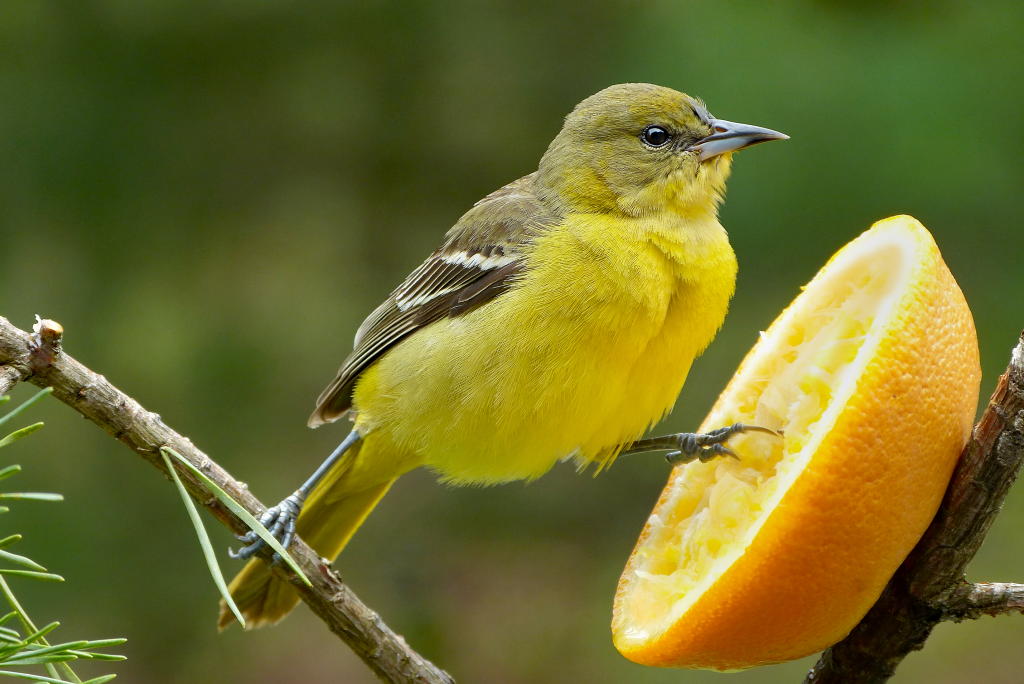
Orchard Orioles can be observed in Nebraska during the breeding season from mid-May to September, appearing in 23% of summer checklists.
Female Orchard Orioles exhibit an overall greenish-yellow coloration, with paler undersides and darker backs, along with darker wings and white wingbars.
Icterus spurius
Length: 5.9-7.1 in (15-18 cm)
Weight: 0.6-1.0 oz (16-28 g)
Wingspan: 9.8 in (25 cm)
During summer, Orchard Orioles breed in the eastern half of the United States before migrating south to Mexico and Central America.
Orchard Orioles prefer open woodlands but can also be found along riverbanks, in open shrublands, farms, and even backyards. They construct hanging pouch-like nests.
Their diet primarily consists of insects such as ants, caterpillars, beetles, and grasshoppers, along with spiders. They also consume nectar from flowers and feed on fruits like mulberries and chokeberries.
Listen to the jumbled series of whistles produced by Orchard Orioles:
Nests of Orchard Orioles are cup-shaped and constructed by females using long grasses. These nests are suspended from small branches of trees and supported by grass and leaf platforms. They lay 4-6 eggs, which take about two weeks to hatch.
To attract Orchard Orioles to your yard, consider placing hummingbird feeders or platform feeders with cut oranges or mangoes. Planting native berry-producing plants like mulberries or chokeberries can also be enticing.
Fun fact: Orchard Orioles are the smallest species of blackbirds found in North America.
9. Western Kingbird
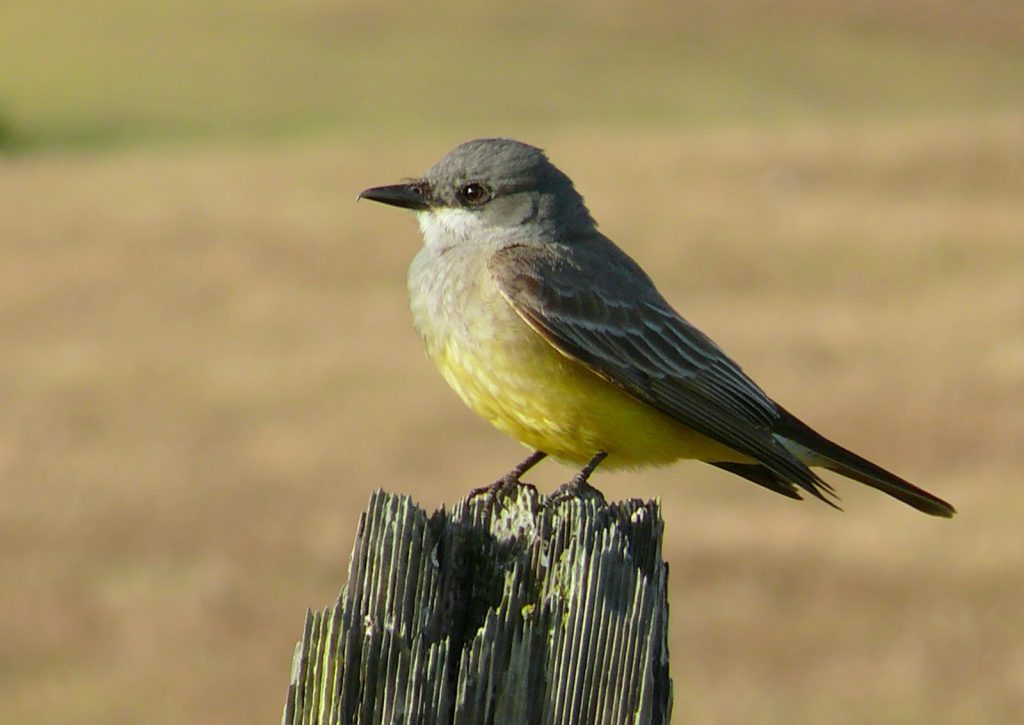
Western Kingbirds can be spotted in Nebraska during the breeding season from April to mid-October, appearing in 20% of summer checklists.
These large flycatchers have yellow bellies, whitish chests, gray heads, grayish-brown wings, and black tails with white edges.
Tyrannus verticalis
Length: 7.9-9.4 in (20-24 cm)
Weight: 1.3-1.6 oz (37-46 g)
Wingspan: 15.0-16.1 in (38-41 cm)
Western Kingbirds breed in summer in western US states, the plains area, and parts of Canada. They migrate to Mexico and Central America during winter, while some individuals may overwinter in southern Florida.
You can find Western Kingbirds in open habitats, often perched on fences and utility lines, patiently waiting to catch flying insects mid-flight.
Listen to the call of the Western Kingbird:
Nests of Western Kingbirds are usually built in trees or shrubs, but they may also utilize human-made structures like buildings or posts. The female constructs the nest using twigs, grass, and plant material, forming a cup-shaped structure.
They lay up to seven eggs, which take around two to three weeks to hatch.
The young birds remain in the nest for a similar duration.
To attract Western Kingbirds to your yard, create an insect-friendly environment and consider planting elderberry or hawthorn trees, which provide both food and nesting opportunities.
Fun fact: Western Kingbird parents continue to feed their young for approximately three weeks after they leave the nest.
10. Yellow-rumped Warbler
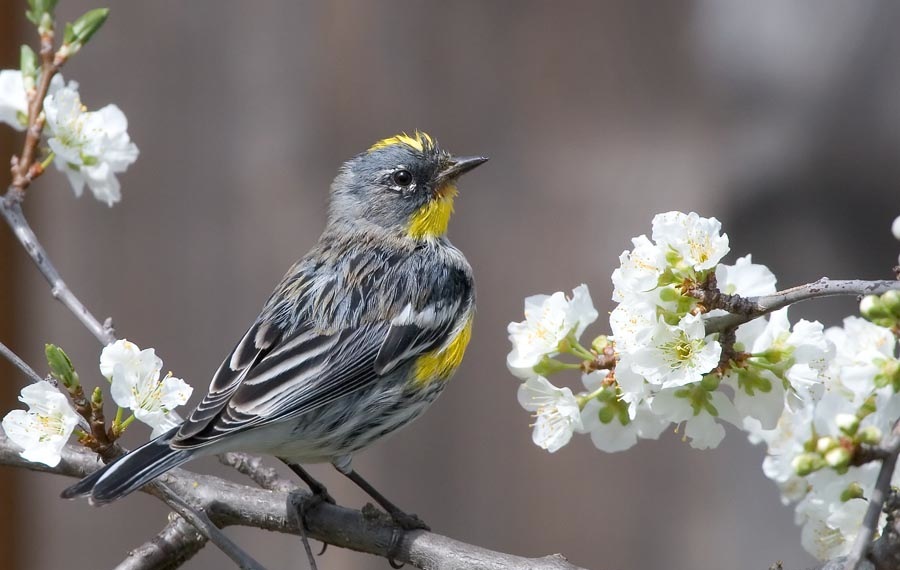
Yellow-rumped Warblers are winter visitors in Nebraska, with their numbers increasing during spring and fall migration. They can be observed in up to 35% of checklists during these periods.
These warblers display gray plumage with yellow highlights on the face, sides, and rump, along with white patches in the wings. Winter individuals exhibit paler brown coloring, with bright yellow rumps and sides that transition back to gray in spring.
Setophaga coronata
Length: 4.7-5.5 in (12-14 cm)
Weight: 0.4-0.5 oz (12-13 g)
Wingspan: 7.5-9.1 in (19-23 cm)
Yellow-rumped Warblers primarily breed in Canada, parts of the Rockies, and the Appalachian mountains.
They can be observed during migration in the Midwest, while wintering individuals are found in open areas with fruiting shrubs. During summer, their diet consists mostly of insects, while in winter, they feed on fruit such as bayberry and wax myrtle.
Listen to the song of the Yellow-rumped Warbler:
Nests of Yellow-rumped Warblers are constructed by females in conifer trees, using twigs, pine needles, and grass, and lined with soft grass, moss, and hair. They lay up to six eggs, which take around two weeks to hatch, followed by another two weeks for the young to leave the nest.
To attract Yellow-rumped Warblers to your backyard, provide sunflower seeds, suet, raisins, and peanut butter.
Fun fact: Yellow-rumped Warblers form large flocks during winter, with numbers reaching into the thousands. They can display aggressive behavior towards other species that get too close.
11. Orange-crowned Warbler

Orange-crowned Warblers can be observed in Nebraska during migration seasons. They are recorded in ebird checklists from birdwatchers during these times.
These warblers display subtle plumage, with olive-green upperparts and pale yellow undersides. The orange crown for which they are named is often hidden and difficult to see.
Oreothlypis celata
Length: 4.7-5.1 in (12-13 cm)
Weight: 0.3-0.4 oz (9-11 g)
Wingspan: 7.5-7.9 in (19-20 cm)
Orange-crowned Warblers breed across western North America and parts of Canada. They migrate through Nebraska during spring and fall.
You can find Orange-crowned Warblers in a variety of habitats, including woodlands, shrubby areas, and gardens. They actively forage for insects and occasionally eat berries.
Listen to the song of the Orange-crowned Warbler:
Nests of Orange-crowned Warblers are cup-shaped structures built in shrubs or low trees, using plant fibers, grass, and other materials. They lay 4-6 eggs, which hatch in around two weeks.
12. Nashville Warbler
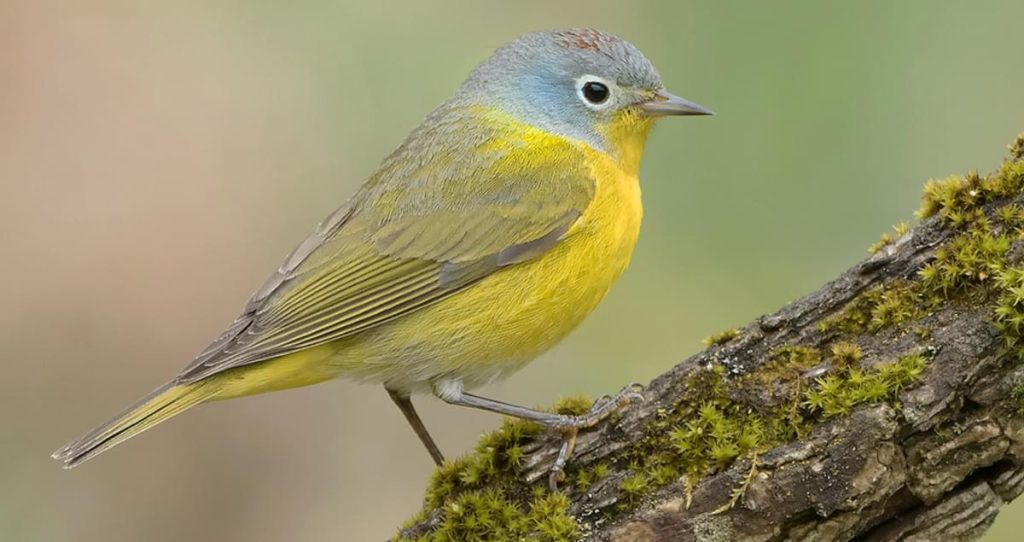
Nashville Warblers can be spotted in Nebraska during migration seasons. They are recorded in ebird checklists from birdwatchers during these times.
These small warblers showcase olive-green upperparts, bright yellow undersides, and a gray head with a distinctive white eye ring.
Leiothlypis ruficapilla
Length: 4.7-5.1 in (12-13 cm)
Weight: 0.3-0.4 oz (9-11 g)
Wingspan: 7.5-7.9 in (19-20 cm)
Nashville Warblers breed in Canada and parts of the northeastern US. They migrate through Nebraska during spring and fall, making them occasional visitors to the state.
You can find Nashville Warblers in deciduous and mixed forests, as well as shrubby areas. They actively forage for insects, spiders, and other arthropods.
Listen to the song of the Nashville Warbler:
Nests of Nashville Warblers are cup-shaped structures built in shrubs or low trees, using plant fibers, grass, and other materials. They lay 4-5 eggs, which hatch in approximately two weeks.
13. Wilson’s Warbler
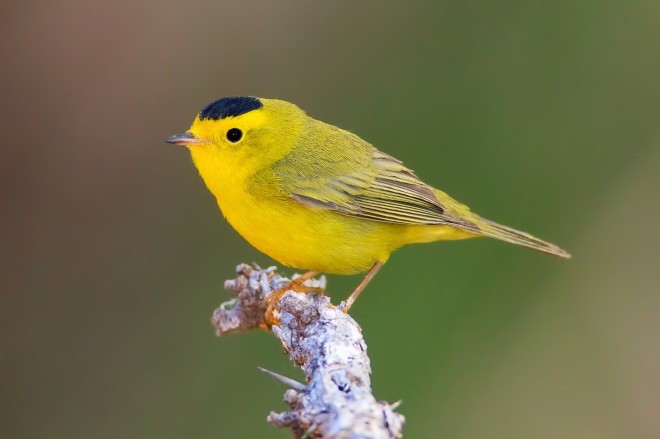
Wilson’s Warblers can be observed in Nebraska during migration seasons. They are recorded in ebird checklists from birdwatchers during these times.
These small, vibrant warblers showcase bright yellow plumage with a distinct black cap on the males. Females have a duller yellow coloration.
Cardellina pusilla
Length: 4.3-4.7 in (11-12 cm)
Weight: 0.2-0.3 oz (6-8 g)
Wingspan: 6.7-7.5 in (17-19 cm)
Wilson’s Warblers breed in western North America and parts of Canada. They migrate through Nebraska during spring and fall, making occasional appearances in the state.
You can find Wilson’s Warblers in a variety of habitats, including dense shrubs, forests, and riparian areas. They actively forage for insects, spiders, and other arthropods.
Listen to the song of the Wilson’s Warbler:
Nests of Wilson’s Warblers are cup-shaped structures built close to the ground, often hidden among vegetation. They lay 4-6 eggs, which hatch in around two weeks.
14. Magnolia Warbler
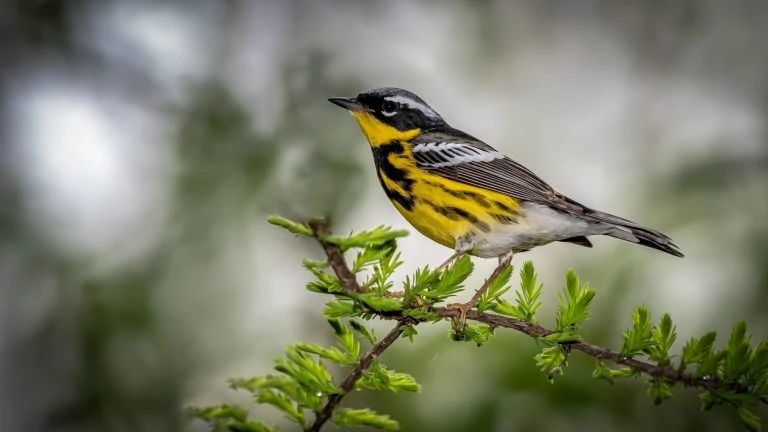
Magnolia Warblers can be observed in Nebraska during migration seasons. They are recorded in ebird checklists from birdwatchers during these times.
These medium-sized warblers display striking black streaks on a bright yellow breast, with a contrasting white belly. They also have a black mask on their face.
Setophaga magnolia
Length: 4.7-5.1 in (12-13 cm)
Weight: 0.3-0.4 oz (9-11 g)
Wingspan: 7.5-7.9 in (19-20 cm)
Magnolia Warblers breed in the boreal forests of Canada and migrate through Nebraska during spring and fall. They are occasional visitors to the state.
You can find Magnolia Warblers in various habitats, including forests, woodlands, and shrubby areas. They actively forage for insects, often gleaning them from foliage.
Listen to the song of the Magnolia Warbler:
Nests of Magnolia Warblers are cup-shaped structures built in shrubs or low trees, using twigs, grass, moss, and other materials. They lay 4-5 eggs, which hatch in approximately two weeks.
15. Palm Warbler
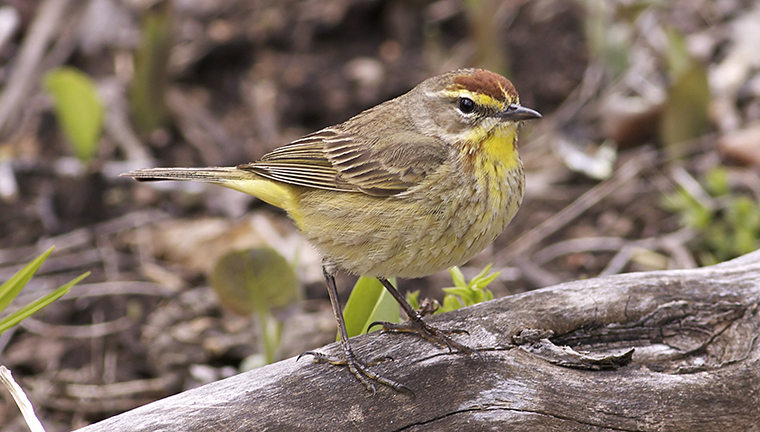
Palm Warblers can be spotted in Nebraska during migration seasons. They are recorded in ebird checklists from birdwatchers during these times.
These small warblers showcase brown upperparts, yellow undertail coverts, and a bright yellow throat and breast with streaking. They often wag their tails, which is a distinctive behavior.
Dendroica palmarum
Length: 4.7-5.1 in (12-13 cm)
Weight: 0.3-0.4 oz (9-11 g)
Wingspan: 7.9-8.7 in (20-22 cm)
Palm Warblers breed in the boreal forests of Canada and migrate through Nebraska during spring and fall. They are occasional visitors to the state.
You can find Palm Warblers in various habitats, including forests, thickets, and open areas with shrubs. They actively forage for insects on the ground, often bobbing their tails.
Listen to the song of the Palm Warbler:
Nests of Palm Warblers are cup-shaped structures built on or near the ground, usually hidden among vegetation. They lay 4-5 eggs, which hatch in approximately two weeks.
16. Western Tanager

Western Tanagers can be observed in Nebraska during migration seasons. They are recorded in ebird checklists from birdwatchers during these times.
These colorful birds exhibit a bright yellow body with a contrasting black back, wings, and tail. Males also feature a red-orange head.
Piranga ludoviciana
Length: 6.3-7.1 in (16-18 cm)
Weight: 0.7-1.1 oz (19-31 g)
Wingspan: 9.8-11.8 in (25-30 cm)
Western Tanagers breed in western North America and parts of Canada. They migrate through Nebraska during spring and fall, occasionally making appearances in the state.
You can find Western Tanagers in various habitats, including coniferous forests, mixed woodlands, and open areas with trees. They actively forage for insects, spiders, and fruit.
Listen to the song of the Western Tanager:
Nests of Western Tanagers are cup-shaped structures built on branches of trees, often near the trunk. They lay 3-5 eggs, which hatch in approximately two weeks.
17. Black-throated Green Warbler
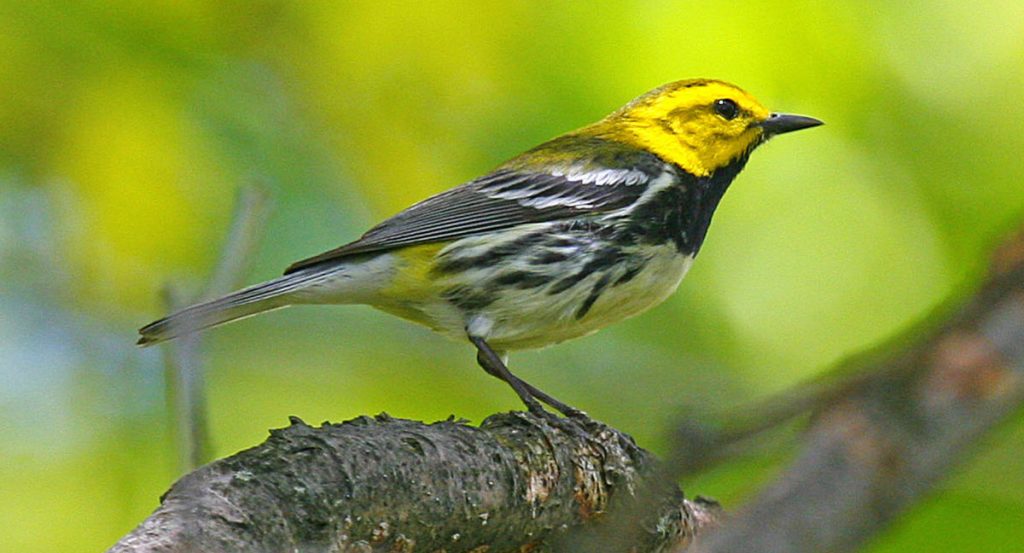
Black-throated Green Warblers can be observed in Nebraska
during migration seasons. They are recorded in ebird checklists from birdwatchers during these times.
These small warblers exhibit yellow underparts, olive-green upperparts, and a distinctive black throat and face. Males also have a contrasting yellow face.
Setophaga virens
Length: 4.7-5.1 in (12-13 cm)
Weight: 0.3-0.4 oz (9-11 g)
Wingspan: 7.5-7.9 in (19-20 cm)
Black-throated Green Warblers breed in the boreal forests of Canada and parts of the northeastern US. They migrate through Nebraska during spring and fall, occasionally making appearances in the state.
You can find Black-throated Green Warblers in various habitats, including forests, woodlands, and shrubby areas. They actively forage for insects, often in the upper canopy.
Listen to the song of the Black-throated Green Warbler:
Nests of Black-throated Green Warblers are cup-shaped structures built in shrubs or low trees, using twigs, grass, and other materials. They lay 3-5 eggs, which hatch in approximately two weeks.
18. Canada Warbler
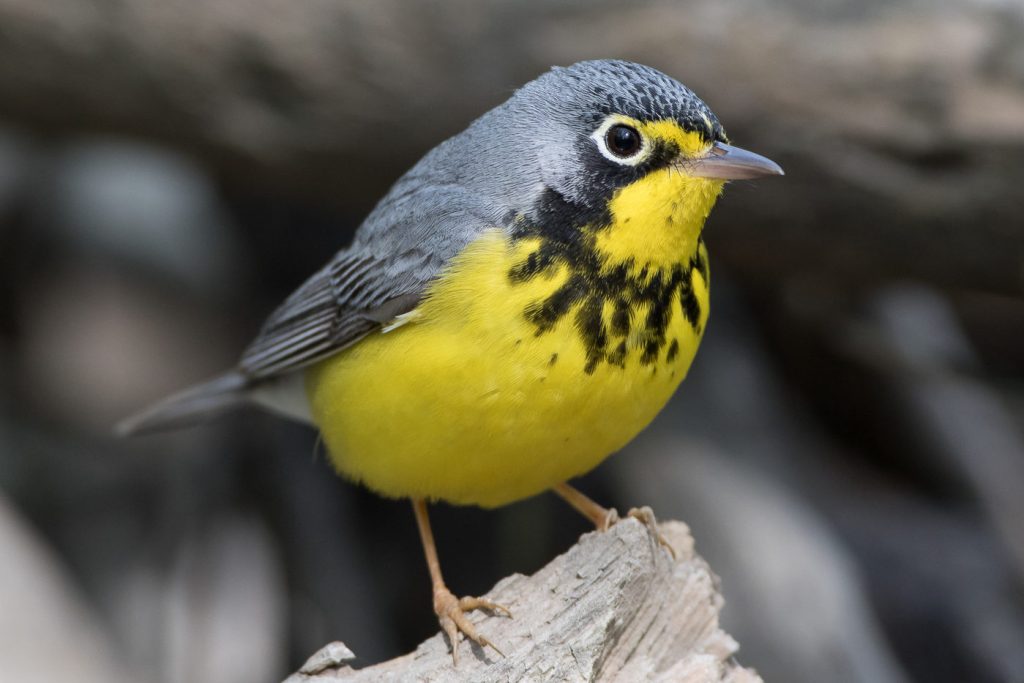
Canada Warblers can be spotted in Nebraska during migration seasons. They are recorded in ebird checklists from birdwatchers during these times.
These medium-sized warblers showcase a slate-blue back, yellow underparts, and a distinctive necklace-like pattern of black streaks on their yellow throat.
Cardellina canadensis
Length: 4.7-5.1 in (12-13 cm)
Weight: 0.3-0.4 oz (9-11 g)
Wingspan: 7.5-7.9 in (19-20 cm)
Canada Warblers breed in the boreal forests of Canada and parts of the northeastern US. They migrate through Nebraska during spring and fall, occasionally making appearances in the state.
You can find Canada Warblers in various habitats, including wet woodlands, swamps, and riparian areas. They actively forage for insects, spiders, and other arthropods.
Listen to the song of the Canada Warbler:
Nests of Canada Warblers are cup-shaped structures built close to the ground, often hidden among vegetation. They lay 3-5 eggs, which hatch in approximately two weeks.
19. Hooded Warbler
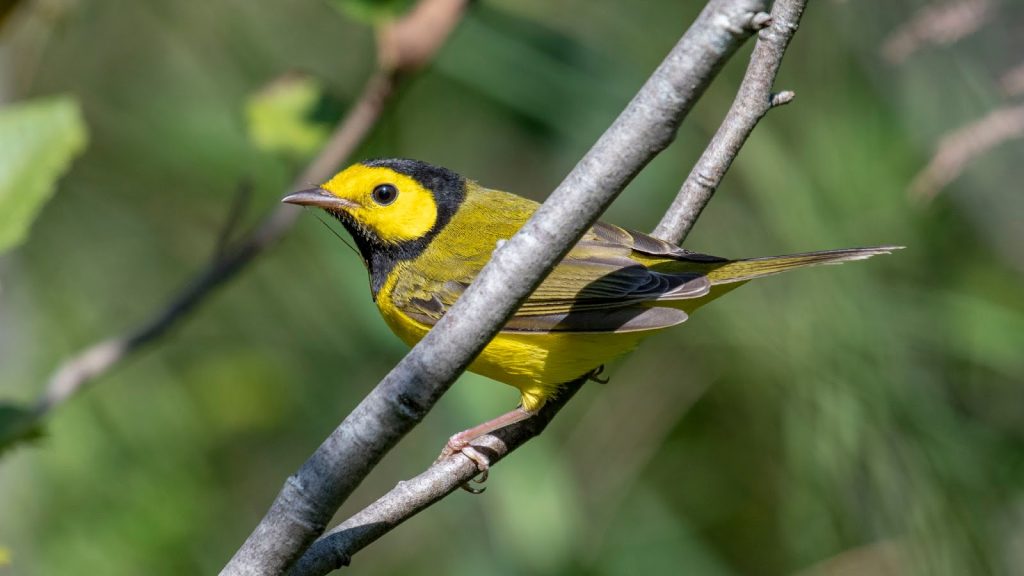
Hooded Warblers can be observed in Nebraska during migration seasons. They are recorded in ebird checklists from birdwatchers during these times.
These medium-sized warblers display a bright yellow face, underparts, and tail, with a contrasting black hood and back. Males have a wider black hood than females.
Setophaga citrina
Length: 4.7-5.1 in (12-13 cm)
Weight: 0.3-0.4 oz (9-11 g)
Wingspan: 7.5-7.9 in (19-20 cm)
Hooded Warblers breed in the southeastern US and migrate through Nebraska during spring and fall, occasionally making appearances in the state.
You can find Hooded Warblers in various habitats, including deciduous forests, thickets, and shrubby areas near water. They actively forage for insects and other arthropods.
Listen to the song of the Hooded Warbler:
Nests of Hooded Warblers are cup-shaped structures built close to the ground, often hidden among vegetation. They lay 3-5 eggs, which hatch in approximately two weeks.
20. Pine Warbler
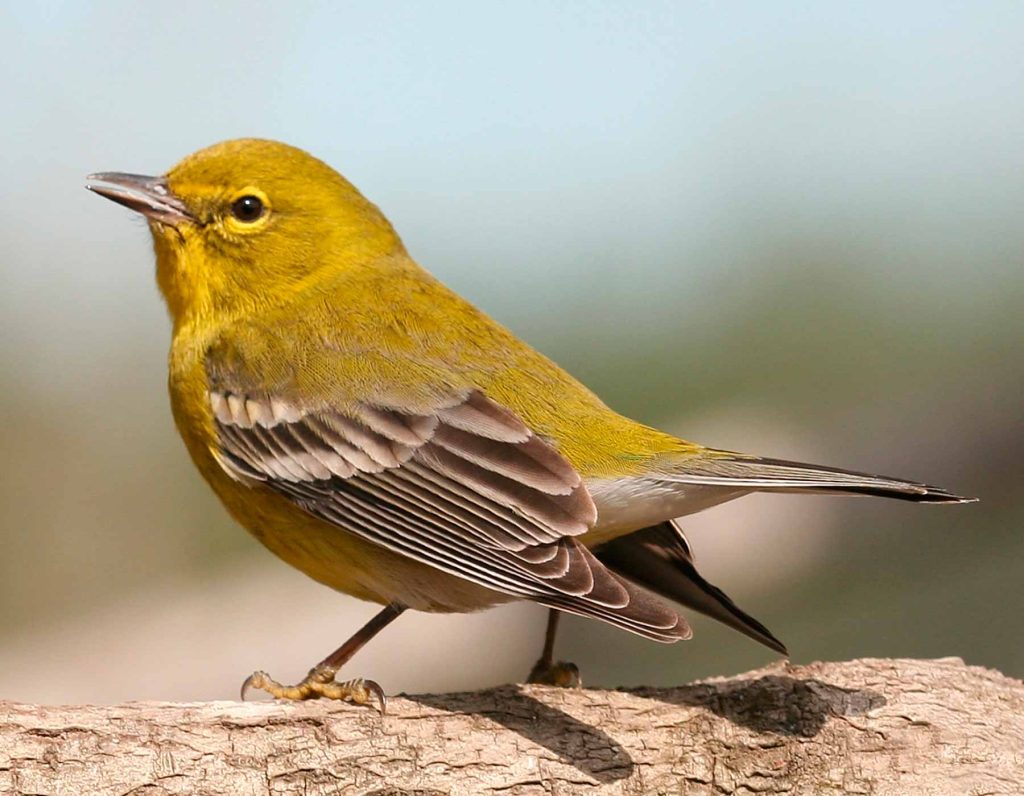
Pine Warblers can be observed in Nebraska during migration seasons. They are
recorded in ebird checklists from birdwatchers during these times.
These medium-sized warblers exhibit yellow plumage overall, with streaks of brown on their back. They have a slender bill and a distinctive face pattern.
Setophaga pinus
Length: 4.7-5.1 in (12-13 cm)
Weight: 0.3-0.4 oz (9-11 g)
Wingspan: 7.5-7.9 in (19-20 cm)
Pine Warblers breed in pine forests of the eastern US and migrate through Nebraska during spring and fall, occasionally making appearances in the state.
You can find Pine Warblers in various habitats, including pine forests, mixed woodlands, and open areas with scattered trees. They actively forage for insects, often in the upper canopy.
Listen to the song of the Pine Warbler:
Nests of Pine Warblers are cup-shaped structures built on branches of trees, often near the trunk. They lay 3-5 eggs, which hatch in approximately two weeks.
21. White-eyed Vireo
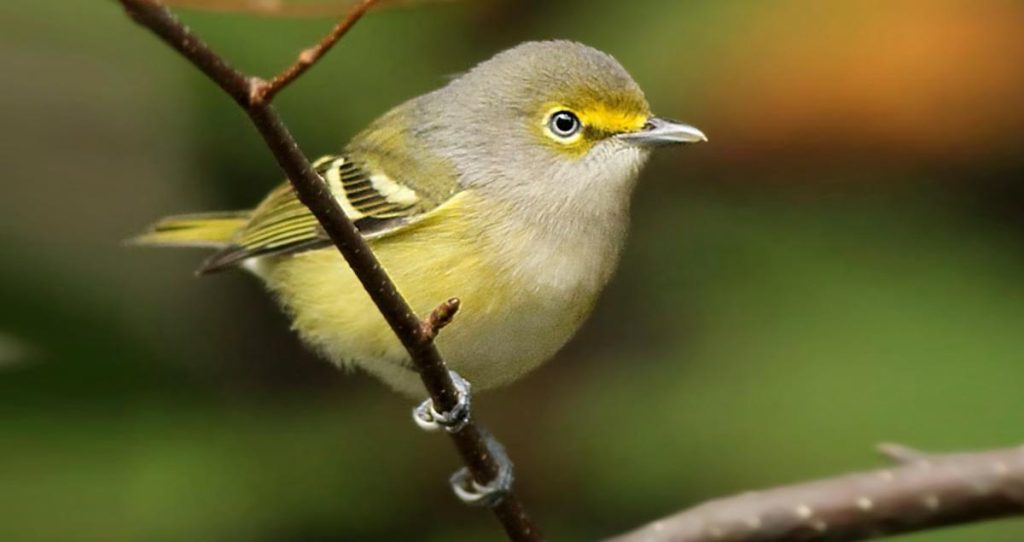
White-eyed Vireos can be spotted in Nebraska during migration seasons. They are recorded in ebird checklists from birdwatchers during these times.
These small songbirds exhibit yellow underparts, olive-green upperparts, and a distinctive white eye ring. They also have a gray crown and yellowish flanks.
Vireo griseus
Length: 4.7-5.1 in (12-13 cm)
Weight: 0.3-0.4 oz (9-11 g)
Wingspan: 7.5-7.9 in (19-20 cm)
White-eyed Vireos breed in the southeastern US and migrate through Nebraska during spring and fall, occasionally making appearances in the state.
You can find White-eyed Vireos in various habitats, including thickets, shrubby areas, and woodland edges. They actively forage for insects, spiders, and other arthropods.
Listen to the song of the White-eyed Vireo:
Nests of White-eyed Vireos are cup-shaped structures built in dense vegetation, often low to the ground. They lay 3-5 eggs, which hatch in approximately two weeks.
22. Blue-winged Warbler
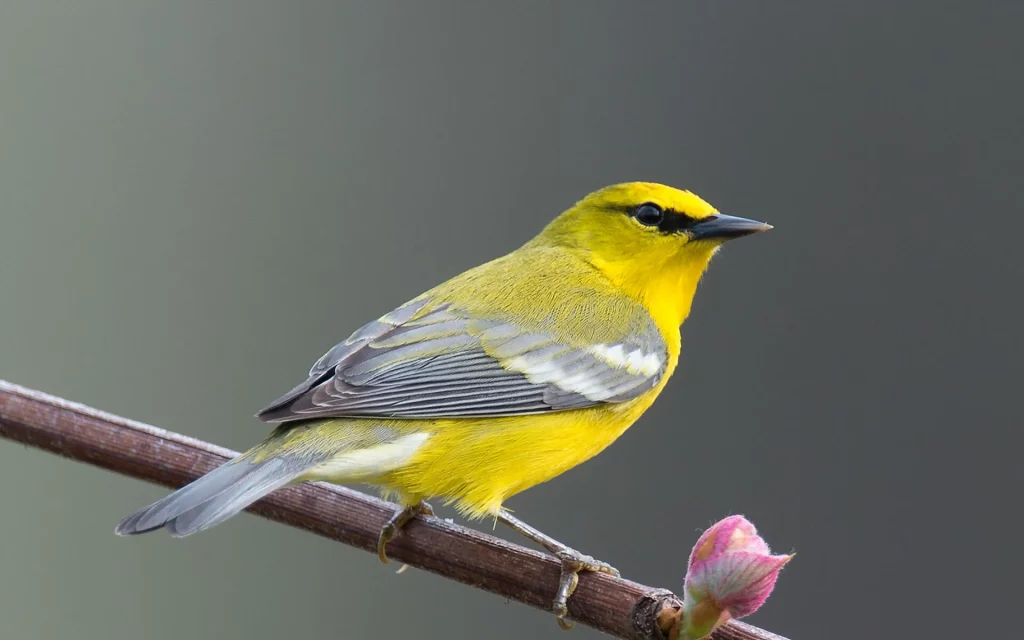
Blue-winged Warblers can be observed in Nebraska during migration seasons. They are recorded in ebird checklists from birdwatchers during these times.
These small warblers showcase bright yellow underparts, olive-green upperparts, and a contrasting blue-gray patch on their wings.
Vermivora cyanoptera
Length: 4.7-5.1 in (12-13 cm)
Weight: 0.3-0.4 oz (9-11 g)
Wingspan: 7.5-7.9 in (19-20 cm)
Blue-winged Warblers breed in the eastern US and migrate through Nebraska during spring and fall, occasionally making appearances in the state.
You can find Blue-winged Warblers in various habitats, including open woodlands, shrubby areas, and edges of wetlands. They actively forage for insects, spiders, and other arthropods.
Listen to the song of the Blue-winged Warbler:
Nests of Blue-winged Warblers are cup-shaped structures built close to the ground, often hidden among vegetation. They lay 3-6 eggs, which hatch in approximately two weeks.
23. American Goldfinch
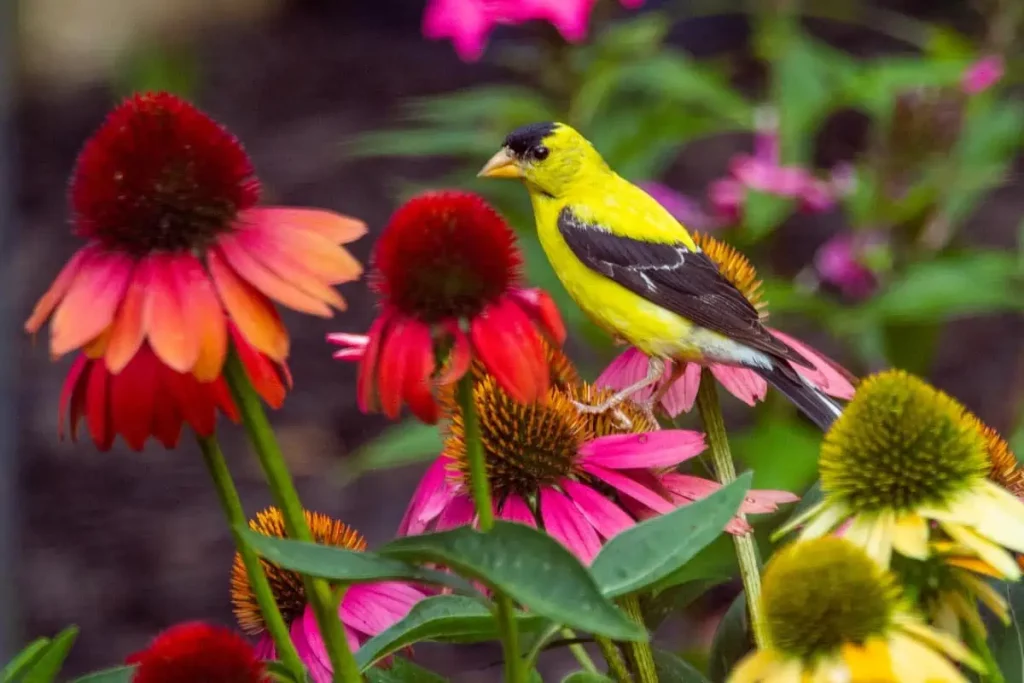
American Goldfinches can be observed in Nebraska all year round. They are recorded in ebird checklists from birdwatchers throughout the year.
These small finches display bright yellow plumage during the
breeding season, with black wings and a distinctive black cap on males. Females have a duller yellow coloration.
Spinus tristis
Length: 4.3-5.1 in (11-13 cm)
Weight: 0.4-0.7 oz (11-20 g)
Wingspan: 7.5-8.7 in (19-22 cm)
American Goldfinches breed across much of North America and are commonly found in Nebraska. They remain in the state throughout the year.
You can find American Goldfinches in various habitats, including open fields, meadows, and suburban gardens. They primarily feed on seeds from various plants, especially thistles.
Listen to the song of the American Goldfinch:
Nests of American Goldfinches are cup-shaped structures built in shrubs or small trees, using plant fibers, grass, and other materials. They lay 3-7 eggs, which hatch in around two weeks.
24. Indigo Bunting

Indigo Buntings can be spotted in Nebraska during migration seasons and the breeding season. They are recorded in ebird checklists from birdwatchers during these times.
These small songbirds exhibit bright blue plumage in males and brown plumage in females. Males have a darker blue coloration during the breeding season.
Passerina cyanea
Length: 4.7-5.1 in (12-13 cm)
Weight: 0.4-0.5 oz (11-14 g)
Wingspan: 7.5-8.3 in (19-21 cm)
Indigo Buntings breed across eastern and central North America and migrate through Nebraska during spring and fall. Some individuals also breed in the state.
You can find Indigo Buntings in various habitats, including open fields, grasslands, and woodland edges. They primarily feed on seeds and insects.
Listen to the song of the Indigo Bunting:
Nests of Indigo Buntings are cup-shaped structures built in shrubs or low trees, using grass, leaves, and other materials. They lay 3-4 eggs, which hatch in approximately two weeks.
25. Eastern Towhee
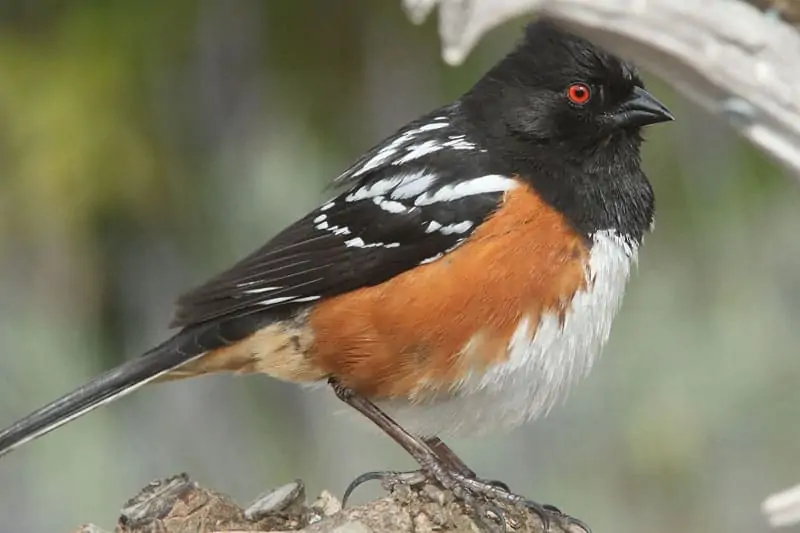
Eastern Towhees can be observed in Nebraska during migration seasons and the breeding season. They are recorded in ebird checklists from birdwatchers during these times.
These medium-sized birds exhibit a black head, back, and tail, with rusty-orange underparts. They have a distinctive white belly and red eyes.
Pipilo erythrophthalmus
Length: 6.8-8.2 in (17-21 cm)
Weight: 1.1-1.8 oz (31-52 g)
Wingspan: 7.9-11 in (20-28 cm)
Eastern Towhees breed across much of eastern North America and migrate through Nebraska during spring and fall. Some individuals also breed in the state.
You can find Eastern Towhees in various habitats, including woodland edges, thickets, and shrubby areas. They actively forage on the ground for insects, seeds, and berries.
Listen to the song of the Eastern Towhee:
Nests of Eastern Towhees are cup-shaped structures built on or near the ground, often hidden among vegetation. They lay 2-6 eggs, which hatch in approximately two weeks.
26. Red-headed Woodpecker
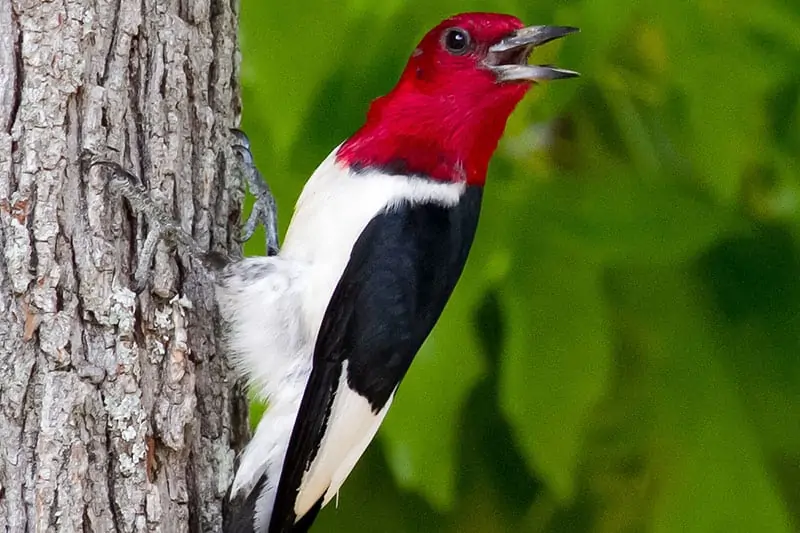
Red-headed Woodpeckers can be spotted in Nebraska during migration seasons and the breeding season. They are recorded in ebird checklists from birdwatchers during these times.
These medium-sized woodpeckers exhibit a bright red head, neck, and throat, with black and white plumage on their body and wings.
Melanerpes erythrocephalus
Length: 7.5-9.4 in (19-24 cm)
Weight: 2.0-3.2 oz (57-91 g)
Wingspan: 16.5-17.7 in (42-45 cm)
Red-headed Woodpeckers breed across much of central and eastern North America and migrate through Nebraska during spring and fall. Some individuals also breed in the state.
You can find Red-headed Woodpeckers in various habitats, including woodlands, forests, and open areas with scattered trees. They actively forage for insects, nuts, and fruits.
Listen to the call of the Red-headed Woodpecker:
Nests of Red-headed Woodpeckers are cavity nests built in dead trees or snags. They lay 4-7 eggs, which hatch in around two weeks.
27. Northern Flicker
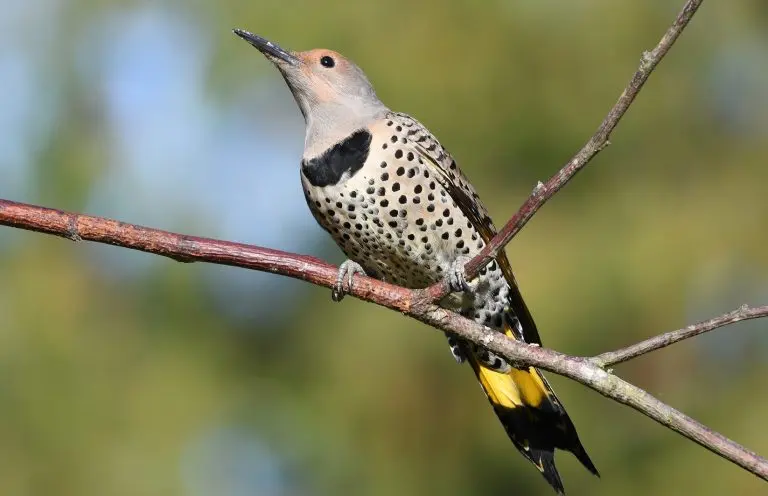
Northern Flickers can be observed in Nebraska all year round. They are recorded in ebird checklists from birdwatchers throughout the year.
These medium-sized woodpeckers display a brown body with black bars on their back, a beige underbelly, and a distinctive white rump patch. Males have a black mustache mark.
Colaptes auratus
Length: 11-14 in (28-36 cm)
Weight: 3.9-5.6 oz (110-160 g)
Wingspan: 16.5-20.1 in (42-51 cm)
Northern Flickers breed across much of North America, including Nebraska. They are resident birds in the state.
You can find Northern Flickers in various habitats, including open woodlands, forest edges, and suburban areas. They primarily forage on the ground for insects and ants.
Listen to the call of the Northern Flicker:
Nests of Northern Flickers are cavity nests built in trees or sometimes in man-made structures. They lay 6-8 eggs, which hatch in around two weeks.
28. Ruby-throated Hummingbird
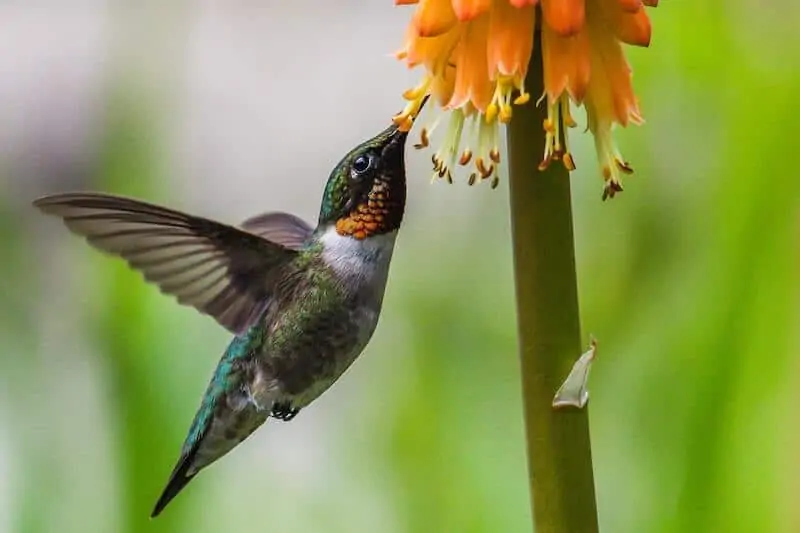
Ruby-throated Hummingbirds can be spotted in Nebraska during migration seasons and the breeding season. They are recorded in ebird checklists from birdwatchers during these times.
These tiny birds exhibit emerald-green upperparts and a bright iridescent ruby-red throat in males. Females have a greenish-white underbelly.
Archilochus colubris
Length: 2.8-3.5 in (7-9 cm)
Weight: 0.1-0.2 oz (2-6 g)
Wingspan: 3.1-4.3 in (8-11 cm)
Ruby-throated Hummingbirds breed in eastern North America and migrate through Nebraska during spring and fall. Some individuals also breed in the state.
You can find Ruby-throated Hummingbirds in various habitats, including woodlands, gardens, and open areas with flowers. They primarily feed on nectar and insects.
Listen to the call of the Ruby-throated Hummingbird:
Nests of Ruby-throated Hummingbirds are cup-shaped structures built on branches using plant fibers, spider silk, and other materials. They lay 1-3 eggs, which hatch in approximately two weeks.
29. Eastern Meadowlark
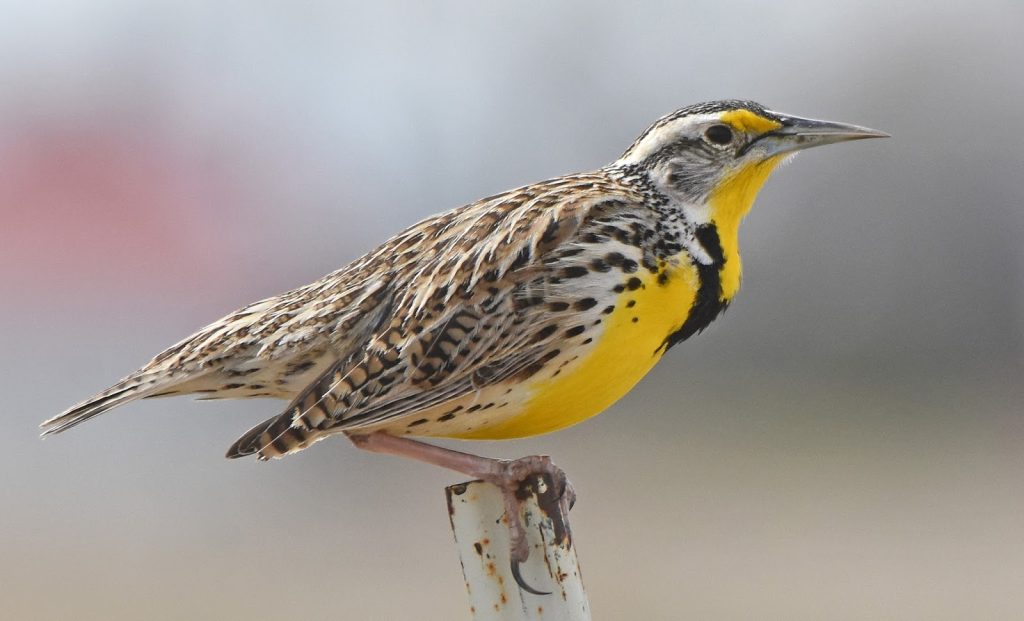
Eastern Meadowlarks can be observed in Nebraska all year round. They are recorded in ebird checklists from birdwatchers throughout the year.
These medium-sized songbirds exhibit a bright yellow underbelly with black streaking, a brown back with black V-shaped markings, and a distinctive yellow throat with a black V-shaped necklace.
Sturnella magna
Length: 7.9-10 in (20-25 cm)
Weight: 4.3-5.9 oz (122-167 g)
Wingspan: 13.4-14.6 in (34-37 cm)
Eastern Meadowlarks breed across much of central and eastern North America, including Nebraska. They are resident birds in the state.
You can find Eastern Meadowlarks in grasslands, meadows, and open fields. They forage on the ground for insects, seeds, and small invertebrates.
Listen to the song of the Eastern Meadowlark:
Nests of Eastern Meadowlarks are cup-shaped structures built on the ground, often hidden among vegetation. They lay 3-6 eggs, which hatch in around two weeks.
30. Northern Bobwhite
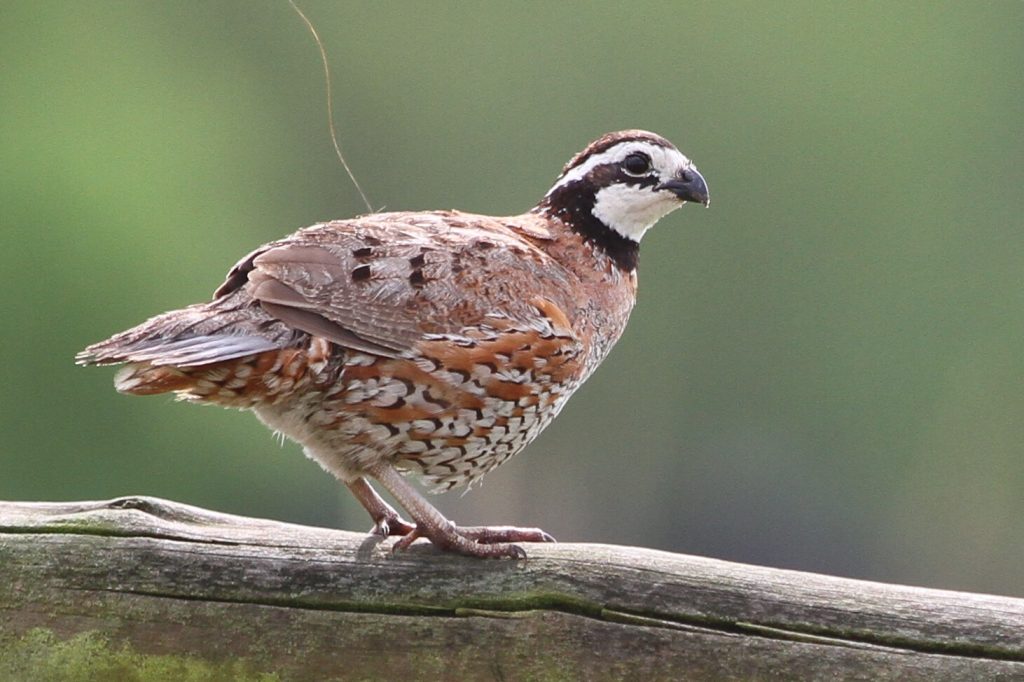
Northern Bobwhites can be spotted in Nebraska all year round. They are recorded in ebird checklists from birdwatchers throughout the year.
These plump, ground-dwelling birds display a mottled brown and white plumage, with a distinctive black and white head pattern. Males have a bold white throat patch.
Colinus virginianus
Length: 9.1-10.6 in (23-27 cm)
Weight: 4.9-6.1 oz (140-173 g)
Wingspan: 14.6-15.7 in (37-40 cm)
Northern Bobwhites are native to much of eastern and central North America, including Nebraska. They are resident birds in the state.
You can find Northern Bobwhites in grasslands, agricultural fields, and open areas with shrubs. They forage on the ground for seeds, insects, and fruits.
Listen to the call of the Northern Bobwhite:
Nests of Northern Bobwhites are ground nests built in shallow depressions, often concealed among vegetation. They lay 10-16 eggs, which hatch in approximately three weeks.
31. Scissor-tailed Flycatcher

Scissor-tailed Flycatchers can be observed in Nebraska during migration seasons and the breeding season. They are recorded in ebird checklists from birdwatchers during these times.
These elegant birds exhibit long tail feathers, with the outer feathers significantly longer than the rest. They have pale gray upperparts and a salmon-pink underbelly.
Tyrannus forficatus
Length: 13-15.4 in (33-39 cm)
Weight: 1.4-1.9 oz (40-54 g)
Wingspan: 15.4-17.7 in (39-45 cm)
Scissor-tailed Flycatchers breed in the southern central US and migrate through Nebraska during spring and fall. Some individuals also breed in the state.
You can find Scissor-tailed Flycatchers in various habitats, including open fields, prairies, and woodland edges. They perch on wires or high perches and catch insects in mid-air.
Listen to the call of the Scissor-tailed Flycatcher:
Nests of Scissor-tailed Flycatchers are cup-shaped structures built in shrubs or low trees, using plant fibers, grass, and other materials. They lay 3-7 eggs, which hatch in around two weeks.